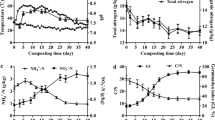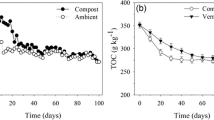Abstract
Microbes perform an important role in the solid-state fermentation (SSF) process, and bacterial communities are more or less abundant depending on the starting materials and the composting procedure. In this study, high-throughput sequencing was used to investigate the changes in bacterial communities in different composting piles containing spent pig litter and distiller grains in five dry weight ratios, i.e., 100% distiller grains (treatment 1), 75% distillers grains/25% spent pig litter (treatment 2), 50% distillers grains/50% spent pig litter (treatment 3), 25% distillers grains/75% spent pig litter (treatment 4), and 100% spent pig litter (treatment 5). The results showed that the fermentation time of the thermophilic stage was prolonged with an appropriate content of distiller grains. The alpha-diversity analysis showed that the variation in bacterial richness and diversity in the various treatments (except treatment 5) was greater in the high-temperature stage than in the inception stage and then was slightly lower in the stabilization stage than in the thermophilic stage. The relative abundance of the predominant bacterial communities differed during different composting stages except in treatment 5. The abundant bacterial communities were similar among the treatments with different proportions of distiller grains (treatments 2, 3, and 4) during the high-temperature stage but differed during the stabilization stage, as increasing proportions of distiller grains increased the relative abundance of the phyla Proteobacteria and Firmicutes, and decreased that of Actinobacteria. Additionally, principal coordinate analysis (PCoA) showed that the bacterial communities in treatments 1, 2, 3, and 4 during the initial stage (day 0) were different from those observed during two other stages (day 10 and day 53), while treatment 5 showed only slight variations in the bacterial community structure in response to changes in the composting process. The results indicated that spent pig litter is not suitable for single-material composting and the addition of an appropriate amount of distiller grains can improve the fermentation process. The understanding of the microbial community diversity at molecular level provided a theoretical basis for the optimization of spent pig litter and/or distiller grain fermentation.





Similar content being viewed by others
References
Aoshima M, Salvador Pedro M, Haruta S, Ding L, Fukada T, Kigawa A, Kodama T, Ishii M, Igarashi Y (2001) Analyses of microbial community within a composter operated using household garbage with special reference to the addition of soybean oil. J Biosci Bioeng 91(5):456–461
Atagana HI (2014) Managing physicochemical parameters in compost systems to enhance degradation of petroleum wastes from a sludge dam. Afr J Biotechnol 13(7):857–865
Belyaeva ON, Haynes RJ, Sturm EC (2012) Chemical, physical and microbial properties and microbial diversity in manufactured soils produced from co-composting green waste and biosolids. Waste Manag 32(12):2248–2257
Benke MB, Hao XY, Caffyn P, Schoenau JJ, McAllister TA (2010) Using manure from cattle fed dried distillers’ grains with solubles (DDGS) as fertilizer: effects on nutrient accumulation in soil and uptake by barley. Agric Ecosyst Environ 139(4):720–727
Chao A (1984) Nonparametric estimation of the number of classes in a population. Scand J Stat 11(4):265–270
Chao A, Lee S (1992) Estimating the number of classes via sample coverage. J Am Stat Assoc 87(417):210–217
Chen QQ, Liu B, Wang JP, Che J, Liu GH, Guan X (2017) Diversity and dynamics of the bacterial community involved in pig manure biodegradation in a microbial fermentation bed system. Ann Microbiol 67(7):491–500
Covino S, Fabianová T, Kresinová Z, Cvancarová M, Burianová E, Filipová A, Vorísková J, Baldrian P, Cajthaml T (2016) Polycyclic aromatic hydrocarbons degradation and microbial community shifts during co-composting of creosote-treated wood. J Hazard Mater 301(8):17–26
Edgar RC (2013) UPARSE: highly accurate OTU sequences from microbial amplicon reads. Nat Methods 10:996–998
Ercolini D (2013) High-throughput sequencing and metagenomics: moving forward in the culture-independent analysis of food microbial ecology. Appl Environ Microbiol 79(10):3148–3155
Foote M (1992) Rarefaction analysis of morphological and taxonomic diversity. Paleobiology 18(1):1–16
Galimberti A, Bruno A, Mezzasalma V, De Mattia F, Bruni I, Labra M (2015) Emerging DNA-based technologies to characterize food ecosystems. Food Res Int 69:424–433
Hamm AC, Tenuta M, Krause DO, Ominski KH, Tkachuk VL, Flaten DN (2016) Bacterial communities of an agricultural soil amended with solid pig and dairy manures, and urea fertilizer. Appl Soil Ecol 103:61–71
Hanson AR, Xu G, Li M, Whitney MH, Shurson GC (2012) Impact of dried distillers grains with solubles (DDGS) and diet formulation method on dry matter, calcium, and phosphorus retention and excretion in nursery pigs. Anim Feed Sci Technol 172(3–4):187–193
Ishii K, Fukui M, Takii S (2000) Microbial succession during a composting process as evaluated by denaturing gel electrophoresis analysis. J Appl Microbiol 89:768–777
Kozich JJ, Westcott SL, Baxter NT, Highlander SK, Schloss PD (2013) Development of a dual-index sequencing strategy and curation pipeline for analyzing amplicon sequence data on the MiSeq Illumina sequencing platform. Appl Environ Microbiol 79(17):5112–5120
Krishnan Y, Bong CPC, Azman NF, Zakaria Z, Othman N, Abdullah N, Ho CS, Lee CT, Hansen SB, Hara H (2017) Co-composting of palm empty fruit bunch and palm oil mill effluent: microbial diversity and potential mitigation of greenhouse gas emission. J Clean Prod 146:94–100
Ley RE, Hamady M, Lozupone C, Turnbaugh PJ, Ramey RR, Bircher JS (2008) Evolution of mammals and their gut microbes. Science 320:1647–1651
Li K, Bihan M, Yooseph S, Methé BA (2012) Analyses of the microbial diversity across the human microbiome. PLoS One 7(6):e32118
Li J, Wang JY, Wang FJ, Wang AG, Yan PS (2017) Evaluation of gaseous concentrations, bacterial diversity and microbial quantity in different layers of deep litter system. Asian-Australas J Anim Sci 30(2):275
Liu KS, Rosentrater K (2011) Distillers grains: production, properties, and utilization. New J Phys 13(6):3099–3104
Liu C, Dong Y, Hou L, Deng N, Jiao R (2017) Acidobacteria community responses to nitrogen dose and form in Chinese fir plantations in southern China. Curr Microbiol 74(3):396–403
Lozupone C, Knight R (2005) UniFrac: a new phylogenetic method for comparing microbial communities. Appl Environ Microbiol 71:8228–8235
Luo J, Fan RQ, Wang T, Gao Y, Liu LZ, Yan SH, Zhang ZH (2015) Evaluation of spent pig litter compost as a peat substitute in soilless growth media. Biol Agric Hortic 31(4):219–229
Lyberg K, Borling J, Lindberg JE (2013) Characterization and nutrient evaluation of wet and dried wheat distillers’ grain for growing pigs. Anim Feed Sci Technol 186(1–2):45–52
Magoč T, Salzberg SL (2011) FLASH: fast length adjustment of short reads to improve genome assemblies. Bioinformatics 27:2957–2963
Maspolim Y, Zhou Y, Guo CH, Xiao KK, Ng WJ (2015) The effect of pH on solubilization of organic matter and microbial community structures in sludge fermentation. Bioresour Technol 190:289–298
Mathur SP (1991) Composting processes. In: Martin AM (ed) Bioconversion of waste materials to industrial products. Elsevier, New York, pp 147–186
Nadia OF, Xiang LY, Lie LY, Anuar DC, Mohd Afandi MP, Baharuddin SA (2015) Investigation of physico-chemical properties and microbial community during poultry manure co-composting process. J Environ Sci 28(2):81–94
Rainisalo A, Romantschuk M, Kontro MH (2011) Evolution of clostridia and streptomycetes in full-scale composting facilities and pilot drums equipped with online temperature monitoring and aeration. Bioresour Technol 102(17):7975–7983
Rausch KD, Belyea RL (2006) The future of co-products from corn processing. Appl Biochem Biotechnol 128(1):47–86
Ren GM, Xu XH, Qu JJ, Zhu LP, Wang TT (2016) Evaluation of microbial population dynamics in the co-composting of cow manure and rice straw using high throughput sequencing analysis. World J Microbiol Biotechnol 32(6):101
Schloss PD, Westcott SL, Ryabin T, Hall JR, Hartmann M, Hollister EB, Lesniewski RA, Oakley BB, Parks DH, Robinson CJ (2009) Introducing mothur: open-source, platform-independent, community-supported software for describing and comparing microbial communities. Appl Environ Microbiol 75:7537–7541
Shen ZZ, Ruan YZ, Wang BB, Zhong ST, Su LX, Li R, Shen QR (2012) Effect of biofertilizer for suppressing Fusarium wilt disease of banana as well as enhancing microbial and chemical properties of soil under greenhouse trial. Biol Fertil Soils 48:807–816
Steger K, Jarvis Å, Vasara T, Romantschuk M, Sundh I (2007) Effects of differing temperature management on development of Actinobacteria populations during composting. Res Microbiol 158:617–624
Team RDC (2012) R: a language and environment for statistical computing R Foundation for statistical computing, Vienna, Austria
Tkachuk VL, Krause DO, Knox NC, Hamm AC, Zvomuya F, Ominski KH, McAllister TA (2014) Targeted 16S rRNA high-throughput sequencing to characterize microbial communities during composting of livestock mortalities. J Appl Microbiol 116(5):1181–1194
Ventura M, Canchaya C, Tauch A, Chandra G, Fitzgerald GF, Chater KF, Sinderen D (2007) Genomics of Actinobacteria: tracing the evolutionary history of an ancient phylum. Microbiol Mol Biol Rev 71:495–548
Wang R, Zhang JY, Sui QW, Wan HF, Tong J, Chen MX, Wei YS, Wei DB (2016) Effect of red mud addition on tetracycline and copper resistance genes and microbial community during the full scale swine manure composting. Bioresour Technol 216:1049–1057
Xi BD, Zhao XY, He XS, Huang CH, Tan WB, Gao RT, Zhang H, Li D (2016) Successions and diversity of humic-reducing microorganisms and their association with physical-chemical parameters during composting. Bioresour Technol 219:204–211
Xiao Y, Zeng GM, Yang ZH, Ma YH, Huang C, Xu ZY, Huang J, Fan CZ (2011) Changes in the actinomycetal communities during continuous thermophilic composting as revealed by denaturing gradient gel electrophoresis and quantitative PCR. Bioresour Technol 102:1383–1388
Xu WJ, Reddy N, Yang YQ (2009) Extraction, characterization and potential applications of cellulose in corn kernels and distillers’ dried grains with solubles (DDGS). Carbohydr Polym 76(4):521–527
Yan ZS, Jiang HL, Cai HY, Zhou YL, Krumholz LR (2015) Complex interactions between the macrophyte acorus Calamus and microbial fuel cells during pyrene and benzo[a]pyrene degradation in sediments. Sci Rep 5(75):10709
Yang TW, Rao ZM, Zhang X, Xu MJ, Xu ZH, Yang ST (2015) Economic conversion of spirit-based distillers’grain to 2,3-butanediol by Bacillus amyloliquefaciens. Process Biochem 50(1):20–23
Zainudin MHM, Hassan MA, Shah UKM, Abdullah N, Tokura M, Yasueda H, Shirai Y, Sakai K, Baharuddin AS (2014) Bacterial community structure and biochemical changes associated with composting of lignocellulosic oil palm empty fruit bunch. Bioresour Technol 9:316–335
Zhang M, Li R, Cao LL, Shi JJ, Liu HJ, Huang Y, Shen QR (2014) Algal sludge from Taihu Lake can be utilized to create novel PGPR-containing bio-organic fertilizers. J Environ Manag 132:230–236
Zhang LL, Ma HX, Zhang HQ, Xun LY, Chen GJ, Wang LS (2015) Thermomyces lanuginosus is the dominant fungus in maize straw composts. Bioresour Technol 197:266–275
Zhang J, Gu LH, Zhang JB, Wu RN, Wang F, Lin GH, Wu B, Lu Q, Meng P (2017) The interaction between nitrogen and phosphorous is a strong predictor of intra-plant variation in nitrogen isotope composition in a desert species. Biogeosciences 14(22):18769–18794
Zhou YX, Runge T (2014) Co-production of feed and furfural from dried distillers’ grains to improve corn ethanol profitability. Ind Crop Prod 55:207–216
Zhou YX, Watson J, Tobimatsu Y, Runge T (2014) Film-forming polymers from distillers’ grains: structural and material properties. Ind Crop Prod 59:282–289
Funding
This research was supported by the State Natural Science Foundation of China (No. 31701993), the Natural Science Foundation of Jiangsu Province, China (No. BK20170613), and the Independent Innovation Project of Jiangsu Province (No. CX(15)1003-07).
Author information
Authors and Affiliations
Corresponding author
Electronic supplementary material
ESM 1
(DOCX 1221 kb)
Rights and permissions
About this article
Cite this article
Zhang, M., Luo, J., Yan, S. et al. Changes in bacterial communities during two agricultural solid wastes’ co-composting processes. Ann Microbiol 68, 743–754 (2018). https://doi.org/10.1007/s13213-018-1379-2
Received:
Accepted:
Published:
Issue Date:
DOI: https://doi.org/10.1007/s13213-018-1379-2




